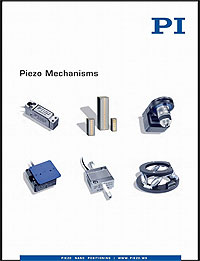AUBURN, Mass., Nov. 10, 2010 — PI (Physik Instrumente) L.P., a manufacturer of piezo ceramic actuators and precision motion-control equipment for semiconductor, biomedical and nanotechnology applications, has released a new catalog on piezo mechanisms.

The 400-page catalog presents PI’s complete spectrum of piezomechanic components and motion systems, from simple, direct actuators to long-travel ceramic linear motors and complex multiaxis flexure-guided nanopositioning stages. A separate section lists the latest digital control electronics.
The catalog also includes a tutorial on piezo design for positioning applications.
The various types of piezo mechanisms available are outlined below. Each type is designed for a unique application category.
Direct Piezo Actuators: Z-Stacks, Shear (X, X-Y)
- Highest force (to 10,000 lbf)
- Fastest response: microseconds to milliseconds
- Short travel ranges: 2-100 µm
Piezo Flexure Lever Actuators
- Longer travel to 2 mm
- Flexure guiding system for straight motion
- Response <1 ms
Ultrasonic Linear Motors
- For high-speed automation and microscopy
- Long travel (tens to hundreds of millimeters)
- Fast: to 500 mm/s
- Low profile, self-locking
PiezoWalk Linear Motors
- High force (4 to 170 lb)
- Compact, self-locking
- Long travel (tens of millimeters)
Piezo Flexure Positioning Stages
- Multiaxis motion, highest precision class (subnanometer)
- Applications in semiconductor technology, nanotechnology, AFM, superresolution microscopy, etc.
The catalog can be downloaded at: http://www.piezo.ws/pdf/Piezo_Mechanism_Cat10.pdf
For more information, visit: www.pi-usa.us